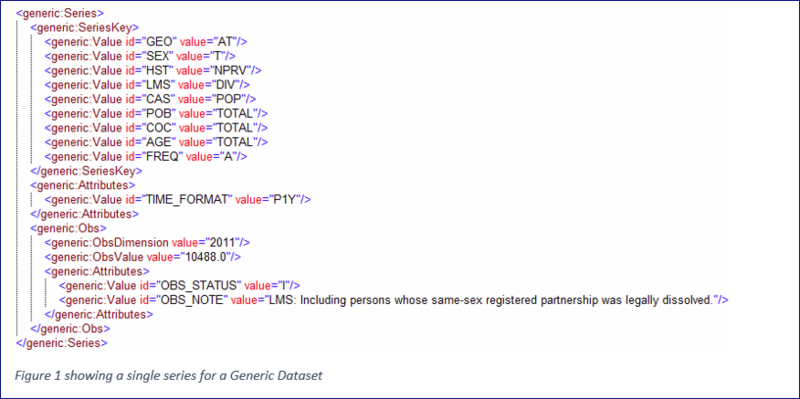Difference between revisions of "SDMX-ML data generic and structure specific"
| Line 1: | Line 1: | ||
| − | |||
| − | |||
=Generic Data= | =Generic Data= | ||
Generic Data is in all versions of the SDMX Standard, each version is supported by the Registry including GenericTimeSeriesData which was introduced in version 2.1 of SDMX. | Generic Data is in all versions of the SDMX Standard, each version is supported by the Registry including GenericTimeSeriesData which was introduced in version 2.1 of SDMX. | ||
Revision as of 07:56, 18 March 2021
Generic Data
Generic Data is in all versions of the SDMX Standard, each version is supported by the Registry including GenericTimeSeriesData which was introduced in version 2.1 of SDMX.
A Generic Dataset is defined by the SDMX Schemas (xsd files) distributed in section 3B of the standard. A Generic Dataset contains the same XML nodes and attributes regardless of the data it is transmitting, hence the name ‘generic’. Below is an example of a series in a Generic Dataset.
The SDMX Schema can validate a Generic Dataset but it cannot be used to verify any values in the reported dataset.
Structure Specific/Compact Data
Structure Specific Data is a SDMX v2.1 re-branding of the term Compact Data which existed in versions 1.0 and 2.0 of the SDMX specification. The Registry supports each version including StructureSpecificTimeSeriesData which was introduced in version 2.1 of the SDMX specification.
Section 3B of the SDMX distribution includes the abstract schema (XSD) definition for a Structure Specific dataset, but the concrete implementation is dependent on what Provision Agreement, Dataflow, or Data Structure Definition the dataset is for.
The Registry is able to generate a Structure Specific XSD on request from the web services page. As the generated Schema is specific to the structural metadata held in the Registry, the level of validation offered by the schema is far greater than with a Generic dataset. A Structure Specific dataset is also more terse then a Generic dataset, as shown in the example below.
SDMX-EDI
SDMX-EDI is a 1990s syntax that uses the UN/EDIFACT syntax. It is an extremely terse data format that supports time series only. The format is still popular for reporting financial data in the Central Banking community. However, unless you have a specific requirement to use this format then it is not recommended as the syntax is largely superseded by 21st century syntaxes such as XML and JSON.
For more information on the structure and syntax of SDMX-EDI, please visit sdmx.org.


